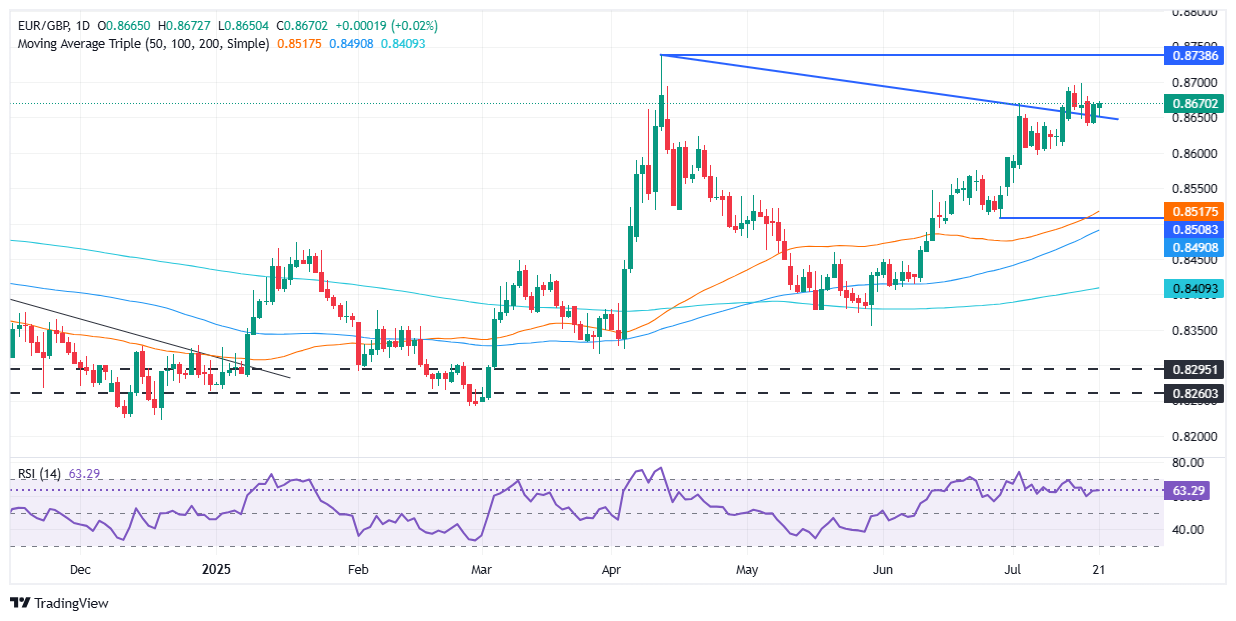- ECB seen holding rates steady this week, with 38% chance of a cut.
- UK inflation hits 1-year high, but BoE still expected to ease by 25 bps in August.
- EU prepares retaliation plan as trade tensions with US threaten to escalate.
The shared currency remains steady against the British Pound on Monday, ahead of a busy week as traders await the monetary policy decision by the European Central Bank (ECB) and a speech by Bank of England (BoE) Governor Andrew Bailey. At the time of writing, the pair trades at 0.8670, virtually unchanged.
Shared currency awaits the ECB decision and Bailey speech; UK rate cut bets grow despite inflation jump
This week, the ECB is expected to keep rates unchanged, according to interest rate probabilities, which show a 62% chance. The odds of a rate cut lie at 38%, according to data from Prime Market Terminal.
Trade news revealed that the EU envoys are set to meet as early as this week to formalize a retaliation plan in the event of a possible no-deal scenario with US President Trump, according to Bloomberg.
Last week, the UK’s economic data was mixed, with a cooling labor market, but inflation unexpectedly rose to its highest level in more than a year. Despite these contrasts, the money market expects a 25-basis-point (bps) rate cut from the BoE at the August 7 meeting, followed by 50 bps of easing towards the end of the year.
Analysts at Goldman Sachs revealed, “We think a rising fiscal risk premium is the main driver of the recent outperformance of EUR/GBP.”
The UK fiscal position is risky after the parliament triggered a U-turn on welfare reforms, increasing doubts about the government’s ability to reduce spending. After that, most economists suggest the government needs to raise taxes to meet its fiscal rules and achieve its growth targets.
EUR/GBP Price Forecast: Technical forecast
The EUR/GBP remains consolidated, though the break of a resistance trendline drawn from the current year’s peak of 0.8738 that passes near 0.8650 was decisively broken, clearing the path for further upside. The Relative Strength Index (RSI) indicates that momentum remains bullish, despite the slope becoming flat.
For a bullish continuation, traders need to surpass the 0.8700 figure so that they can challenge the year-to-date (YTD) high of 0.8738. A breach of the latter will expose 0.8750 and 0.8800. On the other hand, if EUR/GBP falls below 0.8650, expect a decline toward the 20-day SMA at 0.8617, followed by a potential drop to 0.8600.

Euro FAQs
The Euro is the currency for the 19 European Union countries that belong to the Eurozone. It is the second most heavily traded currency in the world behind the US Dollar. In 2022, it accounted for 31% of all foreign exchange transactions, with an average daily turnover of over $2.2 trillion a day.
EUR/USD is the most heavily traded currency pair in the world, accounting for an estimated 30% off all transactions, followed by EUR/JPY (4%), EUR/GBP (3%) and EUR/AUD (2%).
The European Central Bank (ECB) in Frankfurt, Germany, is the reserve bank for the Eurozone. The ECB sets interest rates and manages monetary policy.
The ECB’s primary mandate is to maintain price stability, which means either controlling inflation or stimulating growth. Its primary tool is the raising or lowering of interest rates. Relatively high interest rates – or the expectation of higher rates – will usually benefit the Euro and vice versa.
The ECB Governing Council makes monetary policy decisions at meetings held eight times a year. Decisions are made by heads of the Eurozone national banks and six permanent members, including the President of the ECB, Christine Lagarde.
Eurozone inflation data, measured by the Harmonized Index of Consumer Prices (HICP), is an important econometric for the Euro. If inflation rises more than expected, especially if above the ECB’s 2% target, it obliges the ECB to raise interest rates to bring it back under control.
Relatively high interest rates compared to its counterparts will usually benefit the Euro, as it makes the region more attractive as a place for global investors to park their money.
Data releases gauge the health of the economy and can impact on the Euro. Indicators such as GDP, Manufacturing and Services PMIs, employment, and consumer sentiment surveys can all influence the direction of the single currency.
A strong economy is good for the Euro. Not only does it attract more foreign investment but it may encourage the ECB to put up interest rates, which will directly strengthen the Euro. Otherwise, if economic data is weak, the Euro is likely to fall.
Economic data for the four largest economies in the euro area (Germany, France, Italy and Spain) are especially significant, as they account for 75% of the Eurozone’s economy.
Another significant data release for the Euro is the Trade Balance. This indicator measures the difference between what a country earns from its exports and what it spends on imports over a given period.
If a country produces highly sought after exports then its currency will gain in value purely from the extra demand created from foreign buyers seeking to purchase these goods. Therefore, a positive net Trade Balance strengthens a currency and vice versa for a negative balance.

